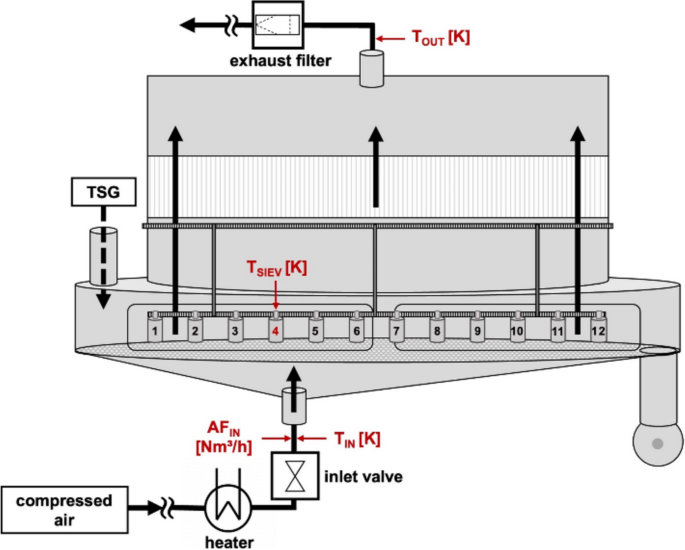Loss-on-Drying Prediction for a Vibrated Fluidised Bed Dryer by Means of Mass and Energy Balances

Abstract
Purpose
Continuous wet granulation and drying require an adequate process control strategy to ensure the product quality. The most important critical quality attributes of dried granules are the granule size distribution and moisture content. Process analytical technologies (PATs) are available for real-time monitoring of moisture content by, e.g., near-infrared spectroscopy (NIRS), which requires additional installation and complex multivariate validation. Thus, a mass and energy balance (MEB) was derived for a vibrated fluidised bed dryer, which is part of the QbCon® 1 intended for continuous wet granulation and drying.
Method
Process parameters that are frequently logged were used for the derivation of a MEB. The predicted MEB was compared with the measured loss-on-drying (LOD) for two different formulations.
Results
The model-derived data were in good agreement with the observed LOD, leading to RMSE values of 0.12–0.45.
Conclusion
The implemented MEB can predict the LOD over time and thus might be suitable as a soft sensor without the installation of additional sensors. The obtained energy flux gives insight into the heat transfer, and the derived energy balance might be used to determine the required energy under certain drying conditions.
Introduction
Twin-screw wet granulation (TSG) has been extensively studied recently [1,2,3,4,5,6,7]. Granule properties can be modified via TSG by changing the powder feed rate [6, 8], liquid-to-solid (L/S) ratio [9, 10], screw speed [8, 11] or screw configuration [3, 12]. Since process manufacturing is changing from traditional batch manufacturing to continuous manufacturing (CM), TSG enables the continuous production of granules. Smaller equipment footprint [2], less waste production [13], better control of product quality [14] and real-time release [13] are some of the advantages of CM. Further processing of the produced granules, e.g. tableting, requires an initial drying step.
There are several dryer types that can be implemented after TSG into a single CM line. A segmented fluidised bed dryer (FBD) is a common method for performing drying semi-continuously. Moreover, CM lines with 6 [15] or 10 [16] segmented drying chambers are well established by the GEA Group (ConsiGma™) [17] and Glatt (ModCos) [18]. A horizontal FBD with a screw conveyer inside the drying chamber was introduced by the company Lödige Process Technology (GRANUCON®) [19]. Inspired by the food industry, where vibrating FBDs (VFBDs) are commonly used, this type is also implemented into a CM line by L.B. Bohle Maschinen und Verfahren (QbCon®) [20, 21]. A CM line from “powder to tablet” via wet granulation and intermediate drying requires an adequate control strategy to ensure product quality [22]. One critical quality attribute (CQA) that needs to be considered is granule moisture, called loss-on-drying (LOD) [22].
Process analytical technologies (PATs) allow real-time monitoring of CQAs such as LOD. Therefore, microwave resonance technology [23], NIRS [24] or Raman spectroscopy [25] is widely used. A disadvantage of these methods is the implementation and validation of an additional sensor [24]. Another approach based on thermodynamics is the calculation using the mass and energy balance (MEB) for real-time LOD control. For the implementation of MEB, a further sensor installation is not necessary as it is based on the already included standard sensors that continuously log process values such as relative humidity, temperature, pressure and air flow of the inlet and outlet air. Regarding dryers intended or implemented for the CM line, the derivation of a MEB was already investigated for the GPCG2 FBD with 10 segments including the usage of NIRS with good prediction of the LOD [24]. In addition, for the 6-segmented FBD of ConsiGma™, a MEB was examined [26] compared to PAT by Raman as well as NIRS [25], which provided good correlations. Mathematical modelling enables the prediction of LOD and was previously introduced for drying via FBD [27] or VFBD [28] in the food industry. In the pharmaceutical field, a mathematical model was investigated for horizontal FBD combined with a screw conveyor using drying kinetics for the prediction of LOD [29]. In addition, for the FBD of ConsiGma™, a process model was established as a soft sensor [30] as well as mechanistic modelling for the simulation of LOD at different granule size fractions [31]. A combination of a data-driven technique using a latent-variable model and a knowledge-driven mechanic model applied for a segmented FBD. Thereby, fault detection and cause detection were obtained [32]. For the VFBD grey box modelling [33], flowsheet simulation [34] and a one-dimensional plug flow model [35] were constructed.
The aim of the present work is the stepwise derivation of a MEB for the continuous VFBD of QbCon® 1 using logged process values of the sensors installed in the drying and granulation unit. This offers the first step toward the development of an orthogonal method, which might be used additional to another PAT method. The applicability of the set MEB to predict the LOD of two different formulations at different LOD ranges was investigated as well for gain insights into the energy flux during heating and drying.
Download the full article as PDF here Loss-on-Drying Prediction for a Vibrated Fluidised Bed Dryer by Means of Mass and Energy Balances
or read it here
Materials
Two formulations were applied for wet granulation and drying, which contained either 97% (w/w) mannitol (Pearlitol 200 SD, Roquette, Lestrem, France) or 80% (w/w) alpha-lactose monohydrate (Granulac® 200, MEGGLE GmbH & Co. KG, Wasserburg am Inn, Germany) and 17% (w/w) microcrystalline cellulose (MCC, VIVAPUR® 101, JRS PHARMA GmbH & Co. KG, Rosenberg, Germany). 3% (w/w) polyvinylpyrrolidone K 30 (Kollidon® 30, BASF SE, Ludwigshafen, Germany) was used as binder in both formulations. Demineralized water served as the granulation liquid.
Kiricenko, K., Hartmann, F., Altmeyer, A. et al. Loss-on-Drying Prediction for a Vibrated Fluidised Bed Dryer by Means of Mass and Energy Balances. J Pharm Innov (2023). https://doi.org/10.1007/s12247-023-09802-w
Read more on “Binder – Pharmaceutical Excipients” here:


